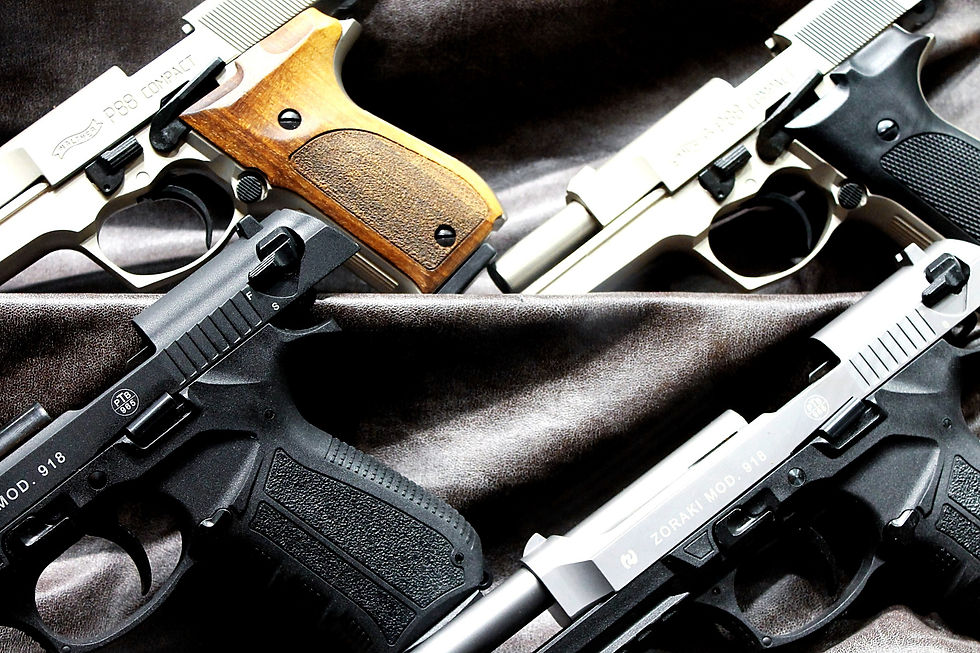
Loading a firearm is crucial for ensuring that the ammunition will cycle properly. If you improperly insert a magazine and dislodge the ammunition, it may not feed properly causing a jam of the weapon. When thinking about having a jammed firearm at the range, it is just an annoyance. In a home defense situation, it could mean the difference between valuable seconds when engaging a threat.
Step 1:
Hold the magazine as shown below. Not only does this provide the greatest contact surface being covered by your hand, but it places your index finger closest to the magazine well when loading. Having this kinesthetic awareness is crucial, especially in low light/no light and/or stressful situations.

Step 2:
Hold the pistol up in front of your face with the magazine well pointed at a roughly 45-degree angle toward the ground. Ensure that your finger is off of the trigger and completely out of the trigger well (Rule #3). This position is considered your “Work Space.” The reason being, you can easily see what you are doing with the pistol and magazine and in an environment where you are performing magazine changes, you can see what is in front of you. If you were engaging a threat you wouldn’t want to drop your weapon and eyes toward the ground just to load a new magazine.

Step 3:
Holding your magazine properly (Step 1) push the magazine into the magazine well firmly until it clicks. At this point you have inserted the magazine and do not want to continue forcefully “jamming” the magazine into the magazine well. Doing so can cause the spring/follower located in the magazine to push the rounds up which can cause a misfeed when loading. If you are unsure if the magazine was seated properly then give the bottom a slight tug. If the magazine comes out then you know you have done it incorrectly.


Step 4:
If you have seated the magazine properly then you now have two choices to load a round:
1.) If the pistol already has the slide FORWARD then you will pull back on the slide forcefully using the Slingshot method or the Over-the-Top method shown in the Clearing section. When performing either of these motions, make sure that you do not “ride” the slide forward. This means, when you pull back on the slide until it is completely to the rear, let it go. DO NOT hold the slide and slowly let it go forward. This will cause a round to come up into the barrel but it will most likely not be loaded properly and the pistol will not be in battery. At this point it is possible that you will pull the trigger and the pistol will not fire.
2.) If the slide is already locked to the rear then you can either perform the Slingshot/Over-the-Top method or you can push the slide lock. Pressing the slide lock (which now acts as a release) using your thumb ensures that the slide will go forward with no interference from you.
At this point, the pistol is loaded with a round in the chamber. There are three types of loading that occur:
1.) Administrative Loading: This process is the first type of loading that you will use to initially chamber a round and make the firearm ready to shoot. The Administrative Reload is described above.
2.) Tactical Reload: The Tactical Reload is used after you have expended rounds from the magazine and you want to have a full magazine in the firearm. You would be taking the partially empty magazine out and immediately replacing it with a full magazine. I will describe and show how to do this in a different post.
3.) Emergency Reload: The Emergency Reload is what you would use when you have run the firearm “dry”-no more ammunition is available in the magazine or chamber-and you are rapidly loading a fresh magazine. I will describe and show how to do this in a different post.
Learning how to properly load your pistol is crucial to successfully operating the firearm.
Stay safe. Stay educated. Stay practical.
-Pat

コメント